The washer method of calculating volumes of revolution
This method is a logical extension of the disk method for finding volumes of revolution. You might want to review that section before going in with this one.
Many figures obtained by revolving a plane figure about an axis have a hole in the middle, like some of the ones below. To find the volumes of these by integration, we can use the disk method; we just need to put a hole in the disk to make it a "washer."

These 3D objects are obtained by revolving the white outline by 360˚ about the $y$-axis.
Area of a "washer"
By "washer," we're referring to a flat ring like the washers used to keep bolts from pulling through their holes.
Finding the area of a washer is simple: Just find the area of the outer circle and subtract the area of the inner circle.
All we need is the two radii ($r$ for the inner circle, $R$ for the outer), which in turn must be expressed as a function of the coordinate axis along which we'll be integrating. Getting those functional relationships will be the crux of getting volumes of revolution right.
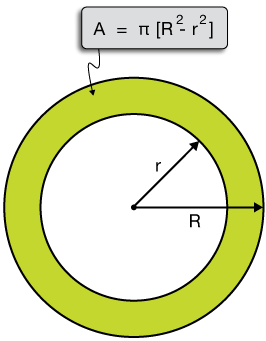
Example 1 : Volume of a torus
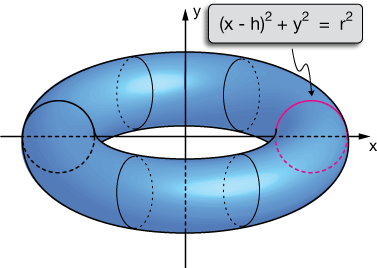

A torus is a donut, more or less. A torus is generated by revolving a circle placed some distance away from an axis by 360˚ about that axis.
The figure on the left (top) shows a circle of radius $r$ that has been translated by $h$ units to the right of the origin, then revolved around the y-axis to make a torus.
Clearly, disks stacked along the $y$-axis will not work to calculate the volume, but if we punch a hole in each disk — make a washer — that would work.
In the lower figure, a single washer is shown inside the torus.
Look at the figure below to see how we use the geometry of the problem to set up our integral, a sum of infinitesimally thin washers stacked along the y-axis to fill the torus. The dimensions of the washer are obtained using Pythagorean relationships in the circular cross section of the torus.

Now the area of the washer as a function of $y$ is:
$$ \begin{align} A_{washer} &= \pi \left( [h + (r^2 - y^2)^{1/2}]^2 - [h - (r^2 - y^2)^{1/2}]^2 \right) \\[5pt] &= \pi [h^2 + (r^2 - y^2) + 2h (r^2 - y^2)^{1/2} - h^2 + 2h (r^2 - y^2)^{1/2} - (r^2 + y^2)] \\[5pt] &= 4\pi h(r^2 - y^2)^{1/2} \end{align}$$
Then we can set up the integral. Here we'll take advantage of the symmetry of the circle to introduce zero as the lower limit. In other words, given that one half of a circle has the same area as the other, integrating between $-r$ and $r$ is the same as twice the integral from 0 to $r$, where $r$ is the radius of the circle.
$$V = 4\pi h \int_{-r}^r (r^2 - y^2)^{1/2} \, dy \; = \; 8\pi h\int_0^r (r^2 - y^2)^{1/2} \, dy$$
Evaluation of this integral is a bit tricky. It involves evaluation of the limit of the inverse tangent function as the argument approaches zero (i.e. the denominator of the argument approaches zero). That limit is $\pi/2$
$$ \begin{align} &4 \pi h \left[ y \sqrt{r^2 - y^2} + y^2 \tan^{-1} \left( \frac{y}{\sqrt{r^2 - y^2}} \right) \right]_0^r \\[5pt] &= 4 \pi h \lim_{y\to r} \, y^2 \tan^{-1} \left( \frac{y}{sqrt{r^2 - y^2}} \right) \\[5pt] &= 4\pi h \cdot \frac{r^2\pi}{2} \end{align}$$
Example 2
Revolution of an area between two 2D curves to form a solid
In this example we'll revolve the region trapped between the curves $f(x) = x^2$ and $g(x)=x^3$ around the $y$-axis to obtain a bowl-like 3D figure.
The washer method is perfect for calculating the volume of this figure. Washers perpendicular to the $y$-axis have the radii shown (→). They were simply found by solving for $x$ from the functions.
The area function can then be found from the radii, $R_1$ and $R_2$:
$$ \begin{align} A &= \pi [y^{1/3})^2 - (y^{1/2})^2] \\ &= \pi (y^{2/3} - y) \end{align}$$
Then we can set up and solve the relatively simple integral:
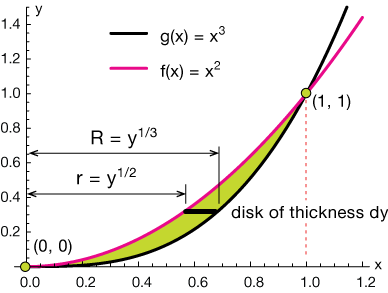
$$V = \pi \int_0^1 (y^{2/3} - y) \, dy = \pi \left[ \frac{3 y^{5/3}}{5} - \frac{y^2}{2} \right]_0^1 = \pi \left[ \frac{3}{5} - \frac{1}{2} \right] = \frac{\pi}{10} \; units^3$$
Example 3
Revolution about an off-axis line
Problem: Find the volume of the figure generated by revolving the area trapped between $f(x) = (x + 2)^{1/2}$ and $g(x) = e^x$ around the horizontal line $y = 2$.
Notice that this figure is not revolved around the x- or y-axis, but a different line, the horizontal line $y = 2$. We have to account for this in our integral or we won't get the right volume. One option is to just translate the figure downward by two units so that we actually revolve around the y-axis, but the distance is the same as in the original problem. Let's do it that way by making $f(x) = (x+2)^{1/2}- 2$ and $g(x) = e^x- 2$.
The points of intersection of these two graphs are tricky to find, so I will tell you that they are x = -1.981 and x = 0.448. I found them numerically on a calculator. These are our limits of integration.
Here is a graph of the problem ↓. The green area is the original problem and the magenta area is our translated version of it. Now you know why we studied all of those function transformations in precalc!
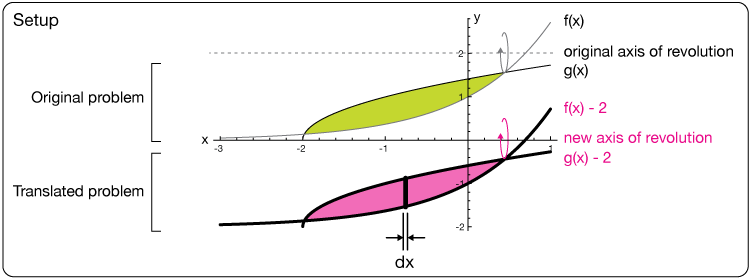
Now we find the area of a washer (thick black line in the figure above), making sure that we use $f(x)$ (black curve) as the outer radius, and $g(x)$ as the inner radius. This will ensure that we calculate a positive area & volume.
$$ \begin{align} A(x) = \pi [(g(x))^2 - (f(x))^2] &\pi[((x + 2)^{1/2})^2 - (e^x)^2] \\[5pt] &= \pi(x + 2 - e^{2x}) \end{align}$$
Then we have a fairly simple integral, only with pesky non-integer limits:
$$ \begin{align} V = \pi \int_{-1.981}^{0.448} (x + 2 - e^{2x}) \, dx &= \pi \left[ \frac{x^2}{2} + 2x - \frac{e^{2x}}{2} \right]_{-1.981}^{0.448} \\[5pt] &= 1.78 \pi = 5.59 \; units^3 \end{align}$$
Rather than take a formulaic approach to off-axis revolution problems, I encourage you to simply apply the appropriate horizontal or vertical translation to an off axis problem to force it to be an on-axis one. It's a general approach that will help you to solve more complicated problems later.
Practice problems
-
Find the volume of the solid generated by revolving the region bounded by the curves $y=x^2$ and $x=y^2$ about the $x$-axis.
Solution

-
The area bounded by $x = 3\pi/2$, $x = 2\pi$, $y = \cos(x)$ and the $x$-axis is revolved around the $y$-axis. Calculate the volume of the resulting solid.
Solution
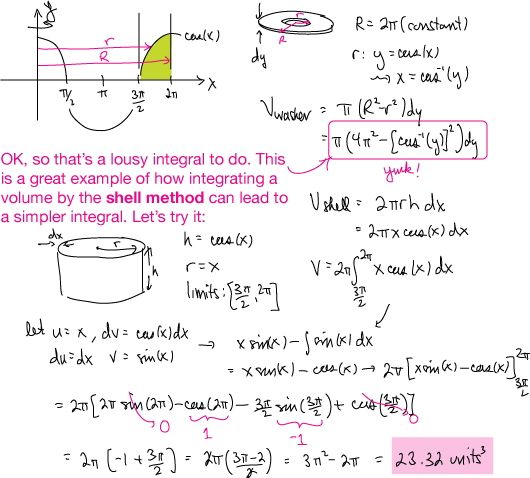
-
Find the volume of the solid formed when the region trapped between $y = (x-5)^2-2$ and $y = -(x-5)^2 + 2$ is revolved around the $y$-axis.
Solution

-
The area bounded by $f(x) = ln(x)$, $x = 1$ and $x = 4$ is revolved about the $y$-axis. Calculate the volume of the resulting solid.
Solution
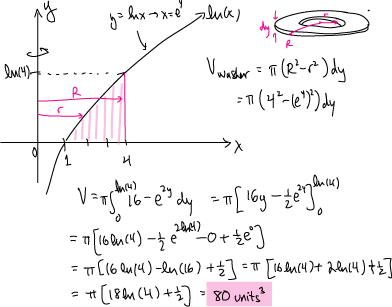
-
The area bounded by $f(x)=e^x$, $x = 0$ and $x = 4$ is revolved about the $y$-axis. Calculate the volume of the resulting solid.
Solution

Video examples
1. Volume of revolution | Washer method ($x$-axis)
Minutes of your life: 3:18
2. Volume of revolution | Washer method ($x$-axis)
Minutes of your life: 3:18

![]()
xaktly.com by Dr. Jeff Cruzan is licensed under a Creative Commons Attribution-NonCommercial-ShareAlike 3.0 Unported License. © 2012-2025, Jeff Cruzan. All text and images on this website not specifically attributed to another source were created by me and I reserve all rights as to their use. Any opinions expressed on this website are entirely mine, and do not necessarily reflect the views of any of my employers. Please feel free to send any questions or comments to jeff.cruzan@verizon.net.